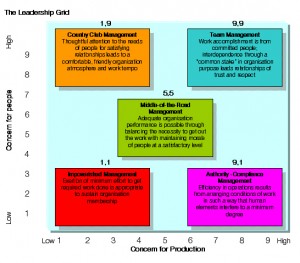Managerial Grid
A diagnostic tool developed by organizational consultants Robert Blake and Jane Mouton, which allows managers to assess their leadership style. In a self-completion questionnaire, managers indicate their behaviour preferences, and the overall score is plotted on two dimensions: concern for people and concern for task. From this, different styles of management can be identified and managers can assess whether they need to change their style. Implicit in the managerial grid approach is the assumption that the most desirable style is a high concern for people and task. However, critics argue that this approach is problematic because it fails to take into account the needs of particular circumstances, and that the appropriateness of particular styles will vary from situation to situation.
The managerial a identifies a range of management behaviour based on the different ways that how production/service oriented and employee oriented states interact with each other. The Managerial grid is also called as instrumental laboratory training as it is a structured version of laboratory training. It consists of individual and group exercises with a view to developing awareness of individual managerial style interpersonal competence and group effeciveness. Thus grid training is related to the leadership styles. The managerial grid focuses on the observations of behaviour in exercises specifically related to work. Participants in this training are encouraged and helped to appraise their own managerial style.
There are 6 phases in the use of the Managerial grid for OD:
First phase is concerned with studying the grid as a theoretical knowledge to understand the human behavior in the Organization.
Second phase is concerned with team work development. A seminar helps the members in developing each member’s perception and the insight into the problems faced by various members on the job.
Third phase is inter group development. This phase aims at developing the relationships between different departments
Fourth phase is concerned with the creation of a strategic model for the organization where Chief Executives and their immediate subordinates participate in this activity.
Fifth phase is concerned with implementation of strategic model.. Planning teams are formed for each department to know the available resources, required resources, procuring them if required and implementing the model
Sixth Phase is concerned with the critical evaluation of the model and making necessary adjustment for successful implementation.
Source


